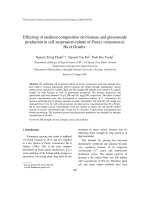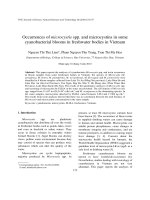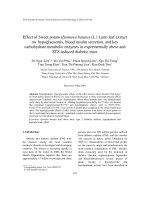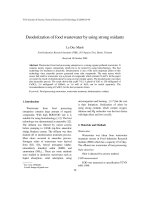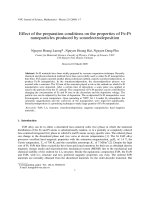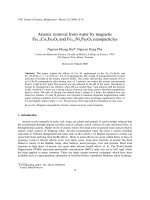Tài liệu Báo cáo " Deodorization of food wastewater by using strong oxidants " pdf
Bạn đang xem bản rút gọn của tài liệu. Xem và tải ngay bản đầy đủ của tài liệu tại đây (121.54 KB, 6 trang )
VNU Journal of Science, Natural Sciences and Technology 25 (2009) 30-34
30
Deodorization of food wastewater by using strong oxidants
Le Duc Manh
Food Industries Research Institute (FIRI), 301 Nguyen Trai, Hanoi, Vietnam
Received 10 October 2008
Abstract. Wastewater from food processing enterprises is a strong organic-polluted wastewater. It
contains mostly organic compounds, which fits to be treated by using biotechnology. The best
technology for treatment is anaerobic. Deodorization is one of the most important points of this
technology since anaerobic process generated some odor compounds. The main reason which
causes bad smell in wastewater was a present of compounds which contains N and S. In this paper
we report the result of deodorization by using several oxidant agents. The deodorization was taken
after anaerobic process. The result shown that at pH 7-8.5, 4 gram/l of CaO or 120 milligram/l of
CaOCl
2
, 2.4 milligram/l of KMnO
4
or 1.6 ml/l of H
2
O
2
can be useful separately. The
recommendation is using of CaOCl
2
for the best economic choice.
Keywords: Food processing wastewater, wastewater treatment, deodorization, oxidant.
1. Introduction
∗
∗∗
∗
Wastewater from food processing
enterprises contains large amount of organic
compounds. With high BOD/COD rate it is
suitable for using biotechnology [1,2]. The best
technology was demonstrated as anaerobic [12].
The influent was filtered by varied screens
before pumping to UASB (up-flow anaerobic
sludge blanket) system. The effluent was then
drained off to deodorization treatment process.
Most odors occurred in anaerobic process.
Strongest odors of wastewater were derived
from H
2
S, SO
2
, benzyl mercaptan (alpha-
toluenthiol), dimethyl sulfur (DMS) and
ammonium (NH
3
) There are some methods
were studied to deodorize wastewater such as
liquid absorption, solid adsorption, using
_______
∗
Tel.: 84-4-38584481.
E-mail:
microorganism and burning [3-7] but the cost
is their limitation. Oxidization of odors by
using strong oxidants which contain oxygen,
chlorine and Mg molecules was the best choice
with high effect and low cost [8].
2. Materials and Methods
Wastewater
Wastewater was taken from wastewater
treatment system in Food Industries Research
Institute (FIRI) which has a capacity 25 m
3
/day.
The effluent was wastewater of beer processing.
Odor detection
Odor is detected by sensory method.
COD measurement
COD was measured as specification TCVN
6491-1999.
L.D. Manh / VNU Journal of Science, Natural Sciences and Technology 25 (2009) 30-34
31
BOD
5
measurement
BOD
5
was measured as specification TCVN
6001-1999.
SS measuarement
Suspended solid was measured as
specification TCVN 6625-2000 (ISO 11923-
1997)
3. Results and Discussions
Influent has COD about 1500 - 1800 mg/l
was pumped to wastewater treatment system
after filtered by varied screens. The properties
of the out stream from anaerobic stage were as
following: pH 6.5-7; COD 150-200 mg/l; SS
80-120 mg/l and quite offensive smell. After
odor treatment, effluent was COD 80-100 mg/l;
pH 7-8 and SS 90-100mg/l. The effect of
several factors was studied to find out the
optimal value. Wastewater was taken after
anaerobic stage for experiments.
pH effect
Since the state of sulfur and organic
compounds is depended on pH, then effects of
pH to the odor of wastewater were studied. The
result in Table 1 showed that pH of influent
effected to sulfur removal process. The odor
intensity is increased with decreasing of pH, it
may due to the incompletely reduction of
compounds of sulfur and nitrogen in acid state.
These compounds are volatile and caused
offensive smell. In pH higher than 7, Ca
2+
precipitated with organic acid then settled in the
filter, this process may reduce COD and SS.
The range of pH 7-8.5 is suitable for
deodorization; this also is an advantage
condition since this range is common in almost
wastewater [1-9].
Treatment time effect
As reported before [13], wastewater was
added 0.4 g/l and 0.25 g/l of CaO and CaOCl
2
respectively. After certain time of treatment,
effluent was taken out and removed precipitate
before measuring other factors. Treatment time
seems not effect to odor and color of
wastewater, this may due to the immediately
reaction of CaOCl
2
with S
2-
and organic
compounds. Results in Table 2 indicated that
odor is diluted by time, but it is not significant.
Then the concentration of oxidant should be
increased rather than elongate the treatment
time.
Effect of CaO concentration
Concentration of CaO was varied in range
of 3.2 to 4.8 g/l with 0.25 g/l of CaOCl
2
added.
The effect of concentration of CaO to the odor
of wastewater was shown in Table 3. When the
concentration of CaO increase, wastewater is
transparence and odorless. S
2+
is totally
removed. This can be explained by precipitation
of Ca
2+
with soluble pollutants.
Effect of CaOCl
2
concentration
Wastewater was added with a range of 40 -
200 mg/l of CaOCl
2
with fixed 4.4 g/l of CaO.
From Table 4 we can see that concentration of
CaOCl
2
effected to color, odor and COD of
wastewater. The higher CaOCl
2
concentration,
the higher effect of odor treatment. With 120
mg/l of CaOCl
2
the factor of effluent was
reached to B class of TCVN 5945-2005.
After combination of results in tables 2, 3
and 4 we demonstrate that 120 mg/l of CaOCl
2
and 4 g/l of CaO is the best condition for
treatment of 1 litre wastewater. After treatment
by oxidants, wastewater was settle and drained
directly to the sewage without any treatment.
L.D. Manh / VNU Journal of Science, Natural Sciences and Technology 25 (2009) 30-34
32
Effect of KMnO
4
concentration
KMnO
4
and H
2
O
2
were added to
wastewater. The results in Table 5 and Table
6.indicated that the higher concentration of
KMnO
4
, the lower COD value of effluent after
treatment, this result is quite similar to previous
reports [10-12]. With 4 g/l KMnO
4
the COD
value of effluent is strange, this may be
explained by the excess amount of KMnO
4
used
which may cause error in measurement. In
general, the optimal concentration is 2.4 g/l of
KMnO
4
.
Table 1. Effect of pH to the odor of wastewater
pH
d
Factors
5,0 6,0 7,0 8,0 8,5
COD
(mg/l) 182 157 101 98 92
BOD
5
(mg/l) 112 97 65 102 57
SS
(mg/l) 95 91 82 88 90
pH
5,2 6,3 7,2 8,3 8,9
Color + + - - -
Odor +++ ++ + + +
Table 2. Effect of treatment time to the odor of wastewater
Time (min) Factors
10 60 120 300
COD
(mg/l) 98 94 94 93
BOD
5
(mg/l) 60 58 58 57
SS
(mg/l) 95 91 82 72
Color - - - -
Odor ++ + + +
Table 3. Effect of CaO concentration to the odor of wastewater
CaO concentration (g/l) Factor
3.2 3.6 4 4.4 4.8
COD
(mg/l) 138 132 125 88 87
BOD
5
(mg/l) 80 75 73 54 55
SS
(mg/l) 112 129 124 127 136
Color - - - - -
Odor ++ + + + +
Table 4. Effect of CaOCl
2
concentration to the odor of wastewater
CaOCl
2
concentration (mg/l) Factors
40 80 120 160 200
COD
(mg/l) 98 82 84 78 105
BOD
5
(mg/l) 60 50 51 50 64
SS
(mg/l) 128 126 115 117 92
Color ++ + - - -
Odor ++ ++ + + +
L.D. Manh / VNU Journal of Science, Natural Sciences and Technology 25 (2009) 30-34
33
Table 5. Effect of KMnO
4
to the odor of wastewater
KMnO
4
concentration (mg/l) Factor
0 0.8 1.6 2.4 3.2 4
COD
(mg/l) 138 132 125 98 87 21
BOD
5
(mg/l) 84 80 76 59 53 65
SS
(mg/l) 137 132 119 117 94 126
Color Black Light
black
Grey Light grey Light grey
Light
violet
Odor +++ ++ + + + +
Table 6. Effect of H
2
O
2
to the odor of wastewater
H
2
O
2
concentration (ml/l) Factor
0 0,4 0,8 1,2 1.6 2
COD
(mg/l) 150 110 85 82 79 77
BOD
5
(mg/l) 91 67 52 50 49 49
SS
(mg/l) 127 112 98 95 95 94
Color Black Grey - - - -
Odor +++ ++ + + + +
Effect of H
2
O
2
concentration
In this study, the concentration of raw H
2
O
2
is 30%. The amounts of H
2
O
2
added to
wastewater were 0.4, 0.8, 1.2, 1.6 and 2.0 ml/l.
The results showed that increasing
concentration of H
2
O
2
caused decreasing COD
of effluent after treatment. Optimal
concentration was found out as 1.6 ml/l (Table
6), at this concentration of H
2
O
2
the COD still
high (186-119 mg/l) but it is suitable for the
following aerobic process.
4. Conclusion
The optimal condition for deodorization
after anaerobic stage should be pH 7-8.5. The
result shown that at pH 7-8.5, 4 gram/l of CaO
or 120 milligram/l of CaOCl
2
, 2.4 milligram/l
of KMnO
4
or 1.6 ml/l of H
2
O
2
can be useful
separately. After combination of the economic
benefit and optimal conditions, we suggest that
CaOCl
2
is the best choice.
References
[1] Le Huy Hoang, Water pollution, Hanoi
University of Science, Education Publishing
house, 1991.
[2] Do Thi Huyen, Nguyen Xuan Nguyen, Pham
Hong Hai, Municiple wastewater treatment.
Education Publishing house, Hanoi, 1998,
p 246 - 253.
[3] Nguyen Van Uyen, Nguyen Tien Thang.
Biotechnology principle, Education Publishing
house, Hanoi, 1999.
[4] Tran Thi Thanh, Microbiology, Education
Publishing house, Hanoi, 2003.
[5] Tran Van Nhan, Ngo Thi Nga, Waswater
treatment technology. Science and Engineering
editor, Hanoi, 2002.
[6] Tran Hieu Nhue, Lam Minh Triet. Wastewater
treatment, Hanoi University of Construction,
Education Publishing house, Hanoi, 2000.
[7] Antharry J. Boonicore, M. CH. E. Waste
management Perry's chemical engineers
handbook. 6
th
ed. Anniversary edition. Section
26. p 3 - 74.
[8] Arora M. Biological Control of Environmental
Pollution. Vol 1, Anmol Publications PVT,
Ltd. India. 1998.
L.D. Manh / VNU Journal of Science, Natural Sciences and Technology 25 (2009) 30-34
34
[9] Ekenfelder W. W. Industrial water pollution
control. Mc, Graw Hill Book Company Inc. p
117 - 137. 1989.
[10] J. Gruller, Small scale of Wastewater
treatment, Construction’s Publishing house,
Hanoi, 1985, p 50 -115.
[11] Ratledge C and Kristiansen B. Basic
Biotechnology. Cambridge University Press,
UK. 2002.
[12] Le Duc Manh, Cao Xuan Thang etc, Complete
the technology of UASB production for
wastewater treatment plant in food processing
company, State project, Food Industries
Research Institute, 2007.
[13] Le Duc Manh, Cao Xuan Thang etc, Study on
high bioactive auto-controlled system for food
wastewater treatment, State project, Food
Industries Research Institute, 2005.
Nghiên cứu khả năng khử mùi của nước thải nhà máy
chế biến thực phẩm bằng một số chất ôxy hóa mạnh
Lê ðức Mạnh
Viện Công nghiệp thực phẩm, 301 Nguyễn Trãi, Hà Nội, Việt Nam
Ô nhiễm nước thải các nhà máy chế biến thực phẩm ñang là vấn ñề ñang ñược cả xã hội quan tâm.
Nhiều ñề tài, dự án khoa học ñã và ñang triển khai nhằm xử lý triệt ñể vấn ñề này. Với ñặc thù ô
nhiễm chủ yếu là các hợp chất hữu cơ, công nghệ chủ ñạo trong xử lý nước thải các nhà máy chế biến
thực phẩm là công nghệ kị khí. Xử lý mùi sau khi xử lý kị khí là một trong những ñiểm mấu chốt của
công nghệ này. Trong phạm vi bài báo này, chúng tôi ñi sâu vào nghiên cứu khả năng khử mùi của
nước thải bằng một số chất ôxy hóa mạnh. Nguyên nhân chính tạo mùi khó chịu trong nước thải là do
các hợp chất có chứa sulphua và nitơ. Một số chất ôxy hóa mạnh như CaO, CaOCl
2
, KMnO
4
, H
2
O
2
ñã
ñược nghiên cứu ñể bổ sung. Xử lý mùi ñược nghiên cứu là xử lý sau quá trình xử lý kị khí. Kết quả
cho thấy, ñiều kiện tốt nhất là pH 7 ñến 8,5, với nồng ñộ CaO 4 g/l hoặc 0.12 g/l CaOCl
2
, 2.4
milligram/l KMnO
4
hoặc 1,6 ml/l của H
2
O
2
30 % cho kết quả khử mùi tốt nhất. Tuy nhiên, ñể có hiệu
quả kinh tế cao nhất thì sử dụng CaOCl
2
là tối ưu.
Từ khóa: Xử lý mùi, chất ôxy hóa mạnh, xử lý nước thải thực phẩm, UASB.
L.D. Manh / VNU Journal of Science, Natural Sciences and Technology 25 (2009) 30-34
45
ðiện thoại: 04-8589895; fax: 04-8584554; email:



